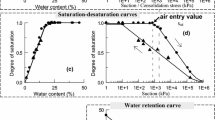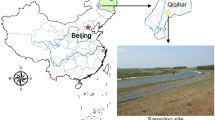Abstract
This paper focuses on the shrinkage behavior of soil specimens involving sand, kaolinite, and kaolinite/sand mixtures subjected to desiccation under controlled conditions. Both, free and restrained shrinkage conditions are studied. The experiments show that pure soils do not curl upon unrestrained shrinkage; however, (under the same conditions) kaolinite/sand mixtures exhibited a marked curling. Furthermore, the mixture with the higher sand content broke through the middle of the sample after displaying a significant curling. Soils subjected to restricted shrinkage developed cracks with slight curling. To simulate the observed behavior, a mechanical model able to reproduce the detachment of the soil sample from the mold is proposed in this work and implemented in a fully coupled hydro-mechanical finite-element code. It is concluded that suction and differential shrinkage are key factors influencing the curling behavior of soils. The proposed framework was able to satisfactorily explain and reproduce the different stages and features of soil behavior observed in the experiments.


















Similar content being viewed by others
References
Allen JRL (1986) On the curl of desiccation polygons. Sediment Geol 46:23–31. https://doi.org/10.1016/0037-0738(86)90003-5
Amarasiri AL, Kodikara JK (2013) Numerical modeling of desiccation cracking using the cohesive crack method. Int J Geomech 13:213–221. https://doi.org/10.1061/(ASCE)GM.1943-5622.0000192
Amarasiri AL, Kodikara JK, Costa S (2011) Numerical modelling of desiccation cracking. Int J Numer Anal Methods Geomech 35:82–96. https://doi.org/10.1002/nag.894
Asahina D, Houseworth JE, Birkholzer JT, Rutqvist J, Bolander JE (2014) Hydro-mechanical model for wetting/drying and fracture development in geomaterials. Comput Geosci 65:13–23. https://doi.org/10.1016/j.cageo.2013.12.009
ASTM C778-17 (2017) Standard Specification for Standard Sand. ASTM Int
Berney IV, Ernest S, Hodo WD, Peters JF, Myers TE, Olsen RS, Sharp MK (2008) Assessment of the effectiveness of clay soil covers as engineered barriers in waste disposal facilities with emphasis on modeling cracking behavior. Nucl. Regul. Comm. Washingt, DC
Bhandari AR, Powrie W, Harkness RM (2012) A digital image-based deformation measurement system for triaxial tests. Geotech Test J. https://doi.org/10.1520/GTJ103821
Borja RI (2000) Finite element model for strain localization analysis of strongly discontinuous fields based on standard Galerkin approximation. Comput Methods Appl Mech Eng. https://doi.org/10.1016/S0045-7825(00)00176-6
Borja RI (2004) Cam-Clay plasticity. Part V: A mathematical framework for three-phase deformation and strain localization analyses of partially saturated porous media. Comput Methods Appl Mech Eng. https://doi.org/10.1016/j.cma.2003.12.067
Bradley WH (1933) Factors that determine the curvature of mud-cracked layers. Am J Sci 26:55–71
Tran H, Wang Y, Nguyen D, Kodikara J, Sánchez M, Bui H (2019) Modelling 3D desiccation cracking in clayey soils using a size-dependent SPHcomputational approach. Comput Geotech 116:103209. https://doi.org/10.1016/j.compgeo.2019.103209
Cleto PR, Manzoli OL, Sánchez M, Maedo MA, Beserra LBS, Guimarães LJN (2020) Hydro-mechanical coupled modeling of hydraulic fracturing using the mesh fragmentation technique. Comput Geotech (Accepted)
Coussy O (2004) Poromechanics. Wiley, New York
Dow DB (1964) The effect of salinity on the formation of mudcracks. Compass Sigma Gamma Epsil 41:162–166
Al-Jeznawi D, Sanchez M, Al-Taie AJ, Zielinski M (2019) Experimental studies on curling development of artificial soils. J Rock Mech Geotech Eng 11(6):1264–1273. https://doi.org/10.1016/j.jrmge.2019.02.006
Gens A, Sánchez M, Guimarães LDN, Alonso EE, Lloret A, Olivella S, Villar MV, Huertas F (2009) A full-scale in situ heating test for high-level nuclear waste disposal: observations, analysis and interpretation. Géotechnique 59:377–399. https://doi.org/10.1680/geot.2009.59.4.377
Gens A, Sánchez M, Sheng D (2006) On constitutive modelling of unsaturated soils. Acta Geotech. https://doi.org/10.1007/s11440-006-0013-9
van Genuchten MT (1980) A closed-form equation for predicting the hydraulic conductivity of unsaturated soils 1. Soil Sci Soc Am J 44:892. https://doi.org/10.2136/sssaj1980.03615995004400050002x
Gilliot JM, Vaudour E, Michelin J (2017) Soil surface roughness measurement: a new fully automatic photogrammetric approach applied to agricultural bare fields. Comput Electron Agric 134:63–78. https://doi.org/10.1016/j.compag.2017.01.010
Graham J, Oswell JM, Gray MN (1992) The effective stress concept in saturated sand-clay buffer. Can Geotech J. https://doi.org/10.1139/t92-121
Gui YL, Hu W, Zhao ZY, Zhu X (2018) Numerical modelling of a field soil desiccation test using a cohesive fracture model with Voronoi tessellations. Acta Geotech. https://doi.org/10.1007/s11440-017-0558-9
Gui YL, Zhao ZY, Kodikara J, Bui HH, Yang SQ (2016) Numerical modelling of laboratory soil desiccation cracking using UDEC with a mix-mode cohesive fracture model. Eng Geol 202:14–23. https://doi.org/10.1016/j.enggeo.2015.12.028
Hirobe S, Oguni K (2016) Coupling analysis of pattern formation in desiccation cracks. Comput Methods Appl Mech Eng 307:470–488. https://doi.org/10.1016/j.cma.2016.04.029
Kindle EM (1926) Contrasted types of mud-cracks. Trans R Soc Canada 20:71–75
Kindle EM, Cole LH (1938) Some mud cracks experiments. Geol Meere Binnergewasser 2:278–283
Kindle E (1917) Some factors affecting the development of mud-cracks. J Geol 25:135–144
Kodikara JK, Nahlawi H, Bouazza A (2004) Modelling of curling in desiccating clay. Can Geotech J 41:560–566. https://doi.org/10.1139/t04-015
Manzoli OL, Gamino AL, Rodrigues EA, Claro GKS (2012) Modeling of interfaces in two-dimensional problems using solid finite elements with high aspect ratio. Comput Struct 94–95:70–82. https://doi.org/10.1016/j.compstruc.2011.12.001
Manzoli O, Sánchez M, Maedo M, Hajjat J, Guimararães LJN (2017) An orthotropic interface damage model for simulating drying processes in soils. Acta Geotech 2017:1–16
Manzoli OL, Maedo MA, Bitencourt LAG, Rodrigues EA (2016) On the use of finite elements with a high aspect ratio for modeling cracks in quasi-brittle materials. Eng Fract Mech. https://doi.org/10.1016/j.engfracmech.2015.12.026
Manzoli OL, Cleto PR, Sánchez M, Guimarães LJN, Maedo MA (2019) On the use of high aspect ratio finite elements to model hydraulic fracturing in deformable porous media. Comput Methods Appl Mech Eng. https://doi.org/10.1016/j.cma.2019.03.006
METER Group (2020) T5 Tensiometer. https://www.metergroup.com/environment/products/t5-tensiometer-water-potential/. Accessed 20 Jan 2020
Minter WEL (1970) Origin of mud polygons that are concave downward. J Sediment Petrol 40:755–764
Morris PH, Graham J, Williams DJ (1992) Cracking in drying soils. Can Geotech J 29:263–277. https://doi.org/10.1139/t92-030
Nouwakpo SK, Huang CH (2012) A simplified close-range photogrammetric technique for soil erosion assessment. Soil Sci Soc Am J 76:70–84
Nuth M, Laloui L (2008) Effective stress concept in unsaturated soils: clarification and validation of a unified framework. Int J Numer Anal Methods Geomech. https://doi.org/10.1002/nag.645
Olivella S, Alonso EE (2008) Gas flow through clay barriers. Géotechnique 58:157–176. https://doi.org/10.1680/geot.2008.58.3.157
Olivella S, Gens A, Carrera J, Alonso EE (1996) Numerical formulation for a simulator (CODE_BRIGHT) for the coupled analysis of saline media. Eng Comput 13:87–112. https://doi.org/10.1108/02644409610151575
Oliver J, Huespe AE, Cante JC (2008) An implicit/explicit integration scheme to increase computability of non-linear material and contact/friction problems. Comput Methods Appl Mech Eng 197:1865–1889. https://doi.org/10.1016/j.cma.2007.11.027
Peron H, Hueckel T, Laloui L, Hu LB (2009) Fundamentals of desiccation cracking of fine-grained soils: experimental characterisation and mechanisms identification. Can Geotech J 46:1177–1201. https://doi.org/10.1139/T09-054
Peron H, Laloui L, Hu LB, Hueckel T (2013) Formation of drying crack patterns in soils: a deterministic approach. Acta Geotech 8:215–221. https://doi.org/10.1007/s11440-012-0184-5
Prazeres PGC, Bitencourt LAG, Bittencourt TN, Manzoli OL (2016) A modified implicit–explicit integration scheme: an application to elastoplasticity problems. J Braz Soc Mech Sci Eng 38:151–161. https://doi.org/10.1007/s40430-015-0343-3
Rodrigues EA, Manzoli OL, Bitencourt LAG Jr, Bittencourt TN, Sánchez M (2017) An adaptive concurrent multiscale model for concrete based on coupling finite elements. Comput Methods Appl Mech Engrg. https://doi.org/10.1016/j.cma.2017.08.048
Rodríguez R, Sánchez M, Ledesma A, Lloret A (2007) Experimental and numerical analysis of desiccation of a mining waste. Can Geotech J 44:644–658. https://doi.org/10.1139/t07-016
Sánchez M, Gens A, Guimarães L (2012) Thermal-hydraulic-mechanical (THM) behaviour of a large-scale in situ heating experiment during cooling and dismantling. Can Geotech J. https://doi.org/10.1139/T2012-076
Sanchez M, Atique A, Kim S, Romero E, Zielinski M (2013) Exploring desiccation cracks in soils using a 2D profile laser device. Acta Geotech 8:583–596. https://doi.org/10.1007/s11440-013-0272-1
Sánchez M, Manzoli OL, Guimarães LJN (2014) Modeling 3-D desiccation soil crack networks using a mesh fragmentation technique. Comput Geotech 62:27–39. https://doi.org/10.1016/j.compgeo.2014.06.009
Shin H, Santamarina JC (2011) Desiccation cracks in saturated fine-grained soils: particle-level phenomena and effective-stress analysis. Geotechnique. https://doi.org/10.1680/geot.8.P.012
Shit PK, Bhunia GS, Maiti R (2015) Soil crack morphology analysis using image processing techniques. Model Earth Syst Environ 1:35. https://doi.org/10.1007/s40808-015-0036-z
Stirling RA, Glendinning S, Davie CT (2017) Modelling the deterioration of the near surface caused by drying induced cracking. Appl Clay Sci 146:176–185. https://doi.org/10.1016/j.clay.2017.06.003
Tran KM, Bui HH, Kodikara J, Sanchez M (2019) Soil curling process and its influencing factors. Can Geotech J. https://doi.org/10.1139/cgj-2018-0489
Tran KM, Bui HH, Sánchez M, Kodikara J (2020) A DEM approach to study desiccation processes in slurry soils. Comput Geotech. https://doi.org/10.1016/j.compgeo.2020.103448
Universitat Politécnica de Catalunya (2019) CODE_BRIGHT - User’s Guide
Valentin C, Bresson LM (1992) Morphology, genesis and classification of surface crusts in loamy and sandy soils. Geoderma. https://doi.org/10.1016/0016-7061(92)90085-L
Ward F (1923) Note on mud cracks. Am J Sci 6:308–309
Witherspoon PA, Wang JSY, Iwai K, Gale JE (1980) Validity of Cubic Law for fluid flow in a deformable rock fracture. Water Resour Res. https://doi.org/10.1029/WR016i006p01016
Zhang X, Li L, Chen G, Lytton R (2014) A photogrammetry-based method to measure total and local volume changes of unsaturated soils during triaxial testing. Acta Geotech 10:55–82. https://doi.org/10.1007/s11440-014-0346-8
Zielinski M, Sánchez M, Romero E, Atique A (2014) Precise observation of soil surface curling. Geoderma 226–227:85–93. https://doi.org/10.1016/j.geoderma.2014.02.005
Acknowledgements
The authors would like to acknowledge the financial support provided by the National Council for Scientific and Technological Development (CNPq, proc: 234003/2014-6) and Texas A&M University through the Texas A&M Energy Institute Graduate Fellowship and the Departmental Fellowship Award. The financial support from NEUP-DOE, USA, through Award DE-NE0008762 is also acknowledged.
Author information
Authors and Affiliations
Corresponding author
Additional information
Publisher's Note
Springer Nature remains neutral with regard to jurisdictional claims in published maps and institutional affiliations.
Rights and permissions
About this article
Cite this article
Maedo, M., Sánchez, M., Aljeznawi, D. et al. Analysis of soil drying incorporating a constitutive model for curling. Acta Geotech. 15, 2619–2635 (2020). https://doi.org/10.1007/s11440-020-00920-0
Received:
Accepted:
Published:
Issue Date:
DOI: https://doi.org/10.1007/s11440-020-00920-0




